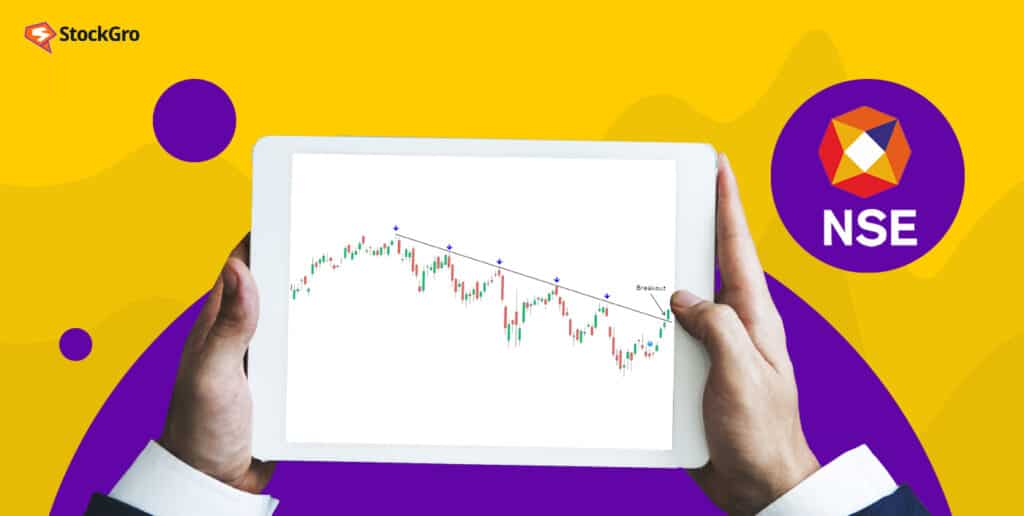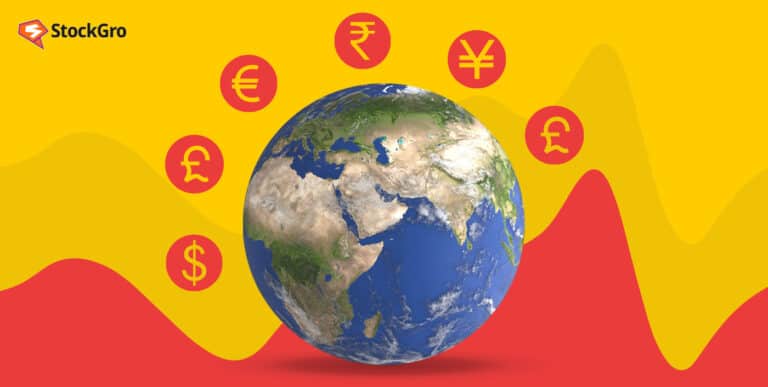
FINNIFTY means Nifty Financial Services Index in India, plays an important role in measuring the performance of the financial market.
This beginner’s guide discusses what FINNIFTY is, what it contains, and how it has performed. It includes banks, NBFCs, insurance companies, and other FTIs. FINNIFTY isn’t just a financial term. It captures the heartbeat of India’s financial system.
What is FINNIFTY?
FINNIFTY is the Nifty Financial Services Index symbol in the Indian stock market. This index was launched in 2021 and powered by NSE, including the stock values of various companies in the Indian financial sector. If the financial sector is doing well, FINNIFTY is likely to gain in value, and vice versa.
FINNIFTY is a scoreboard that combines major Indian money-related businesses. As their performance improves, so does their FINNIFTY score. This makes FINNIFTY a useful tool for monitoring the health of the Indian money business.
You may also like: The simplicity and enigma of debt to equity ratio
Key Components of FINNIFTY
FINNIFTY is made up of different parts, like ingredients in a recipe. These parts are FINNIFTY stock list of 20 companies in India that deal with money matters.
Banks: These are big places where people keep their money.
| HDFC Bank Ltd. | 23.64% |
| ICICI Bank Ltd. | 20% |
| Kotak Mahindra Bank Ltd. | 8.41% |
| Axis Bank Ltd. | 7.66% |
| SBI Ltd. | 6.73% |
Non-Banking Financial Companies (NBFCs) are like banks but offer different services.
| Bajaj Finance Ltd. | 3.08% |
| Bajaj Finserv Ltd. | 2.77% |
| Cholamandalam Investment and Finance Company Ltd. | 1.34% |
| Muthoot Finance Ltd. | 0.40% |
Insurance Companies: They help people by providing insurance.
| ICICI Prudential Life Insurance Company Ltd. | 2.54% |
| HDFC Life Insurance Company Ltd. | 2.22% |
| ICICI Lombard General Insurance Company Ltd. | 1.89% |
Others: These are other companies related to money matters.
| Housing Development Finance Corporation Ltd. | 15.78% |
| Bajaj Holdings & Investment Ltd. | 1.72% |
| Axis Asset Management Company Ltd. | 1.46% |
| ICICI Securities Ltd. | 1.44% |
| Kotak Mahindra Asset Management Company Ltd. | 1.43% |
Combined, these pieces provide a comprehensive picture of Indian financial businesses, allowing us to understand how they are doing.
FINNIFTY option chain
For FINNIFTY, option chains are listings of all available options, including puts & calls, strike prices, live prices, volume, open interest, and more. Futures and options contracts allow investors to speculate on future price movements.
The FINNIFTY index cannot be purchased directly by investors. The data on the option chain is dynamic and can change throughout the trading day. In any case, they can invest in mutual funds whose weightage matches and reflects FINNIFTY’s results.
In addition to banks, FINNIFTY also has a wide scope in other financial institutions, making it a complete package for the Indian financial sector.
Also Read: Leverage in stock market – strategies, risks and rewards
Factors influencing FINNIFTY’s value
What makes FINNIFTY’s value go up and down? There are a few things:
The following hypothetical scenario illustrates the effect the value of FINNIFTY.
Assume that several significant events in the Indian economy affect FINNIFTY’s value in a fictional year.
Macroeconomic Shift: The RBI (Reserve Bank of India) decides to cut interest rates to stimulate economic growth. This makes borrowing cheaper, and many businesses and individuals start taking loans.
Industry-Specific Regulation: At the same time, the government introduces new regulations that make it easier for non-banking financial companies (NBFCs) to operate, expanding their customer base.
Diverse Reactions: Now, here’s where diversification comes into play. FINNIFTY comprises various types of financial businesses. People are borrowing more as interest rates are cut. NBFCs flourish due to the new regulation. A new law in the index imposes stricter claim conditions, reducing the insurers’ profitability.
The outcome of the scenario on FINNIFTY’s value:
- Banks in FINNIFTY: They see a surge in borrowing and post higher profits. Their stock values go up, positively impacting FINNIFTY’s value.
- NBFCs in FINNIFTY: They benefit from relaxed regulations and attract more customers. Their stock values also rise, further boosting FINNIFTY.
- Insurance Companies in FINNIFTY: They face difficulties due to new laws, causing their stock values to drop. This counteracts some of the gains from banks and NBFCs.
Also Read: Investor’s guide to India VIX (volatility index)
Final analysis:
A multifaceted performance like the FINNIFTY index is created by the interaction between various factors that shape its value. It is akin to a complex dance where various players respond to different tunes. The index’s value can be predicted by understanding these factors.
Sectors Involved in FINNIFTY
FINNIFTY includes a wide range of sectors that play a crucial role in India’s financial ecosystem. These sectors provide an in-depth understanding of the financial services market in our country:
- Banks: A major contributor, with top banks like HDFC Bank, ICICI Bank, and SBI forming the backbone. They dominate the index and indicate the overall banking sector’s health.
- Non-Banking Financial Companies (NBFCs): These entities complement banks by offering specialised financial services. Bajaj Finance and Muthoot Finance are notable examples.
- Insurance Companies: Representing the insurance industry’s growth, companies like ICICI Lombard and HDFC Life Insurance contribute significantly.
- Housing Finance: Companies like Bajaj Finserv highlight the role of housing loans and mortgages.
- Asset Management and Securities: Firms like Kotak Asset Management and ICICI Securities showcase the investment and trading aspects of the financial sector.
Together, these sectors represent the financial services industry, making FINNIFTY a solid indicator of India’s financial health.
A Guide to Investing in FINNIFTY
Wondering how to invest in FINNIFTY? Here are the ways:
- Open a Demat Account: This is your gateway to trading in FINNIFTY stocks.
- Mutual Funds: Look for schemes that follow the FINNIFTY pattern.
- Future and Options Contracts: Speculate on future price movements with these financial instruments.
FINNIFTY offers investors an intriguing opportunity to benefit from this dynamic market with strong returns since it was founded.
How is FINNIFTY calculated?
FINNIFTY, or the Nifty Financial Services Index, is designed to track the performance of India’s financial sector, including banks, insurance companies, housing finance firms, and NBFCs. It is calculated using the free-float market capitalization-weighted method, similar to Nifty50 and Bank Nifty.
Here’s how it works:
- Selection of Stocks – The index consists of 20 major financial sector stocks listed on the NSE.
- Free-Float Market Cap – Only the freely available shares (excluding promoter holdings) are considered for weightage.
- Base Year & Base Value – The index was launched with a base value of 1,000 in 2004.
- Daily Price Calculation – FINNIFTY’s value fluctuates in real-time, based on changes in the stock prices of its constituent companies.
Stocks with higher market capitalization and liquidity have a greater impact on FINNIFTY’s movement. The top constituents typically include HDFC Bank, ICICI Bank, Bajaj Finance, and SBI, making it a crucial index for tracking financial sector trends.
How to trade in the FINNIFTY index?
1. Trading via FINNIFTY Options & Futures
FINNIFTY derivatives (futures & options) are popular among traders due to their weekly expiries on Tuesdays and lower margin requirements compared to Bank Nifty.
- FINNIFTY Options – Traders can buy/sell call and put options to capitalize on index movements.
- FINNIFTY Futures – One can go long (buy) if bullish or short (sell) if bearish.
2. Key Trading Strategies
Intraday Trading – Short-term traders use momentum strategies based on price trends.
Swing Trading – Holding positions for a few days to capitalize on larger moves.
Hedging & Portfolio Diversification – Institutions use FINNIFTY to hedge risks in financial sector investments.
3. Lot Size & Margin Requirements
- Lot Size – 40 units per lot
- Margin Requirement – Typically lower than Bank Nifty, making it accessible for retail traders.
Difference between FINNIFTY and BankNifty
| Factor | FINNIFTY | BankNifty |
|---|---|---|
| Sector Focus | Covers entire financial sector (banks, NBFCs, insurance, etc.) | Focuses only on banking stocks |
| No. of Stocks | 20 constituents | 12 constituents |
| Volatility | Comparatively lower due to diversified stocks | Higher due to banking sector fluctuations |
| Expiry Day | Every Tuesday | Every Thursday |
| Lot Size | 40 | 15 |
| Trading Popularity | Growing due to lower risk | Highly liquid & most-traded index |
If you’re looking for a diversified exposure to financial stocks, FINNIFTY is a better choice. However, if you prefer high volatility and quick movements, BankNifty is the go-to index for trading.
Conclusion
FINNIFTY is a vibrant, multifaceted index that provides a window into India’s financial sector. Whether you’re an investor, a financial enthusiast, or a curious beginner, understanding FINNIFTY opens doors to opportunities and insights.
FAQs
How is FINNIFTY different from other stock indices?
FINNIFTY exclusively tracks companies from the financial services sector, unlike indices such as Nifty 50, which cover a broader range of industries. This focus makes FINNIFTY more sector-specific and volatile compared to diversified indices.
What are the key components of the FINNIFTY index?
FINNIFTY includes leading banks (HDFC Bank, ICICI Bank), NBFCs (Bajaj Finance), insurance firms (HDFC Life), and housing finance companies, among others. These 20 companies tell us about how India’s financial sector is performing.
Can retail investors invest in FINNIFTY?
Retail investors cannot directly purchase FINNIFTY but can invest through exchange-traded funds (ETFs) or mutual funds that replicate the index. They can also trade derivatives like futures and options.
What are the benefits of trading in FINNIFTY?
FINNIFTY offers exposure to India’s financial sector, with opportunities for high returns due to its dynamic components. It allows for hedging and speculation using derivatives and you can invest it using various trading strategies.
How can one track the performance of FINNIFTY?
FINNIFTY’s performance is updated in real time on the NSE platform. Investors can monitor it via financial websites, trading apps, or by analysing its derivatives data like option chains.

